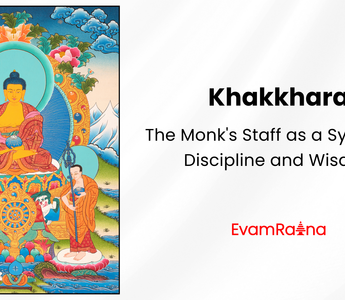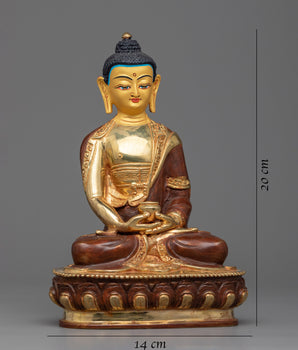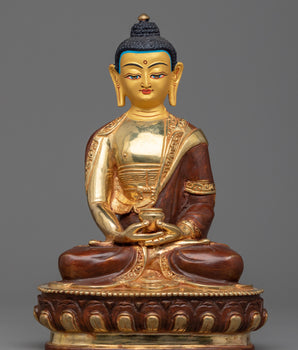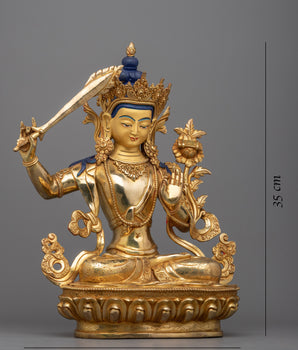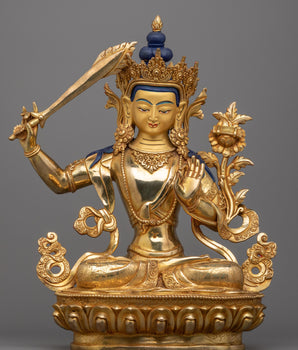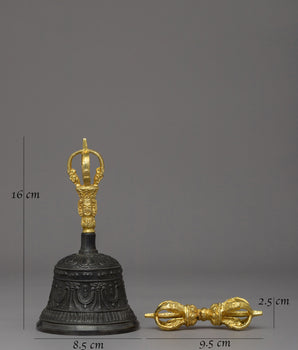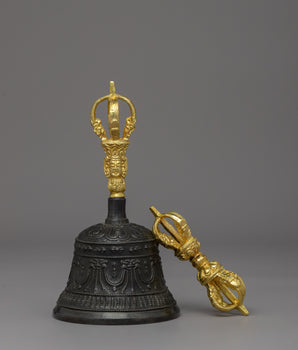Khakkhara Is Also Called Khargsil in Tibetan
Khakkhara, the monastic staff, has a simple but profound spiritual significance among all Buddhist traditions and ritual artifacts. This blessed staff, known as Khar-gsil in the Tibetan culture, is more than just a physical tool. For a Buddhist devotee, it represents a devout commitment to the monastic ways, embodying qualities like renunciation, compassion, and wisdom. Beyond its practical application, the khar sil reminds the practitioner of their vows and discipline to monastic life and esoteric Buddhist practices.
When held by monks and spiritual masters, it denotes their path of enlightenment and spiritual awakening- a sign that one is on the continuous path of seeking truth and the way of humility. In this read, we go in-depth into what the Khakkhara means, its historical context, and how it plays a transformative role in Buddhist philosophy.
What Is a Khakkhara?

The Khakkhara is a sacred staff topped with jingling rings carried by Buddhist monks, Bodhisattvas, and, occasionally, deities. Historically, it served a practical purpose: alerting creatures of the monk's presence to prevent harm and avoid breaking the vow of non-violence. Over time, its role evolved, gaining profound symbolic meaning.
The term "Khakkhara" comes from the Sanskrit words kha (empty) and kara (making), symbolizing the emptiness of worldly attachments. Its design is deliberate: a long shaft with a top section adorned with multiple rings that jingle as it moves. These rings are often arranged in groups, representing elements of the Buddhist path, such as the Four Noble Truths or the Six Perfections.
The Noble Origins of Khakkhara
The tradition of carrying the monk's staff traces its origins to the time of Shakyamuni Buddha. As the legend goes, when Tathagata was teaching and traveling throughout ancient India, he and his followers led a simple, ascetic life. The Buddha and his disciples traveled on foot from place to place, teaching the Dharma and gathering disciples.

The monks encountered difficult terrains, long journeys, and occasional threats from wild animals en route. The compassionate Buddha recognized the challenges faced by his followers, and in response, he introduced the staff as a tool to assist them. This staff was a simple wooden implement that helped the ascetics navigate difficult paths and offered support during long pilgrimages. The jingles served a dual purpose: announced the monk’s arrival, allowing people and animals to avoid accidental harm, and reminded the bearer of their vows and spiritual path.
Meanwhile, another legend says that Sakyamuni himself directed all past, present, and future Buddhas to carry the monk's staff after he attained Buddhahood. He instructed:
"I have attained perfect Buddhahood, follow the same course of conduct as other Buddhas in instructing you. This being the case, you also should carry the monk's staff."
Tathagata then went on to instruct his disciples on how to carry the Khakkhara and its conduct. Thus started the venerated tradition of ascetics carrying the most symbolic staff to remind themselves and the world about the ideals of harmlessness, mindfulness, and discipline.
The Shape of Khakkhara and Their Symbolic Meanings
The monk's staff is made up of three parts that symbolize the miseries of the three planes of lower birth, i.e., animal, spirit, and hell-being. Hence, one needs to contemplate the Three Moral Teachings or trisiksa (bslab-pa-gsun) that are:
- Training in Higher Conduct
- Training in Higher Meditation
- Training in Higher Wisdom
Among the three parts, the upper and lower portions are equal in length and made of iron. Meanwhile, the shorter middle portion is crafted from wood. At the top of the upper portion of the staff is a stupa (mchod-rten). Below this stupa is a second stupa that sits on four metal horns that remind us to understand the Four Noble Truths. The two stupas symbolize two kayas, Dharmakaya and Rupakaya, among the trikayas. Below the four metal horns base, there are three metal rings hanging on each side, totaling twelve rings. And those 12 rings symbolize the 'twelve interdependent chains of causation' that keep us bound in the cycle of rebirths.

Meanwhile, the wooden middle part of the staff appears separated from the upper section by a metal hook. The hook is used to hang the monastic stick when not in use. The hook is usually made of steel, which embodies Buddha's compassion. The compassionate hook is an illustration of Buddha's compassionate nature that is delivered from samsara to the sentient beings.
The lower portion of the khar sil includes seven sides crafted from iron. The top part is as thick as the wooden section. Its bottom contains a knot which is a result of many-faceted knobs. The knot is there to remind us of a monk's vows of avoiding birth in the three lower birth planes.
Who Carries The Khakkhara?
The Khakkhara is traditionally carried by monks and religious figures for both functional and symbolic significance. Meanwhile, Buddhist monks, mainly revered in East Asian Buddhism, hold the pewter staff.
In Vajrayana, the monk's staff is typically associated with high-ranking monks, lama figures, and certain deities. The names are listed below:
- Sariputra
- Maudgalyayana
- Kshitigarbha
Sariputra and Maudgalyayana were two of the most prominent and revered disciples of the Buddha. Both were highly respected for their spiritual qualities and played key roles in the early spread of Buddhism. They are often mentioned together because of their close association with Tathagata and their respective roles in the monastic community.
Meanwhile, Bodhisattva Kshitigarbha is a protector who guide beings in the underworld and hell realms, as well as being a source of comfort and rebirth. He is specifically connected with the saving of souls and guiding the dead to a better rebirth. In this way, he plays a key role in ensuring that no beings remain trapped in the realms of suffering, symbolizing compassion and the possibility of salvation.
The Khakkhara in Buddhist Art and Rituals
In Buddhist iconography, the Khakkhara is often depicted in the hands of enlightened beings and revered teachers just like Bodhisattva Kṣitigarbha, who carry it alongside a wish-fulfilling jewel. For Kṣitigarbha, the staff is a tool for liberating beings from the hell realms, symbolizing his ceaseless vow to help all sentient beings.
It is used by monks and tantric practitioners to invoke blessings or clear negative energies in ritual practices. Its rhythmic jingling during ceremonies resonates with the sound of the Dharma spreading across the realms, a reminder of the eternal presence of wisdom. Tibetan lamas use it as a sacred implement, blending its symbolic role with practical applications. In some esoteric rituals, the Khargsil is used to drive away harmful spirits, symbolizing the victory of wisdom over ignorance.
Similarly, the staff is venerated as a monastic accessory in Mahayana and Vajrayana traditions. In East Asia, particularly in China and Japan, the Khakkhara gained prominence with wandering monks and pilgrims. It is known as the xīzhàng in Chinese and the shakujō in Japanese.
The Khakkhara In Modern Practice

Today, the khakkhara remains a potent symbol in Buddhist practice, even as its practical use has diminished. Modern practitioners see it as a reminder of the core values of Buddhism: discipline, compassion, and wisdom. In monastic communities, it continues to play a role in ceremonies, serving as a link between tradition and contemporary practice.
For lay practitioners, the khakkhara serves as a spiritual metaphor. Its jingling rings remind us of the interconnectedness of all beings, and its steady shaft encourages us to stay grounded on our spiritual journey.
Meanwhile, the pilgrim's staff is used in martial arts today, especially in certain traditional East Asian martial arts, mainly in the Shorinji Kempo, a Japanese martial art. However, today, only a small number of martial arts schools teach the use of the shakujo, which has a defensive function that is similar to both the bo and spear. It incorporates thrusting and parrying using the finial or butt end while also employing the shaft for blunt striking and blocking.
The monastic staff stands as a timeless emblem of discipline, wisdom, and compassion. From its origins as a simple walking aid to its spiritual significance in rituals and art, this sacred tool continues to inspire Buddhists across the world. Whether you call it the Khargsil or simply the monk's staff, its teachings resonate universally.


